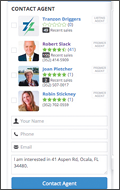Nearly 10 years after Zillow revolutionized the online home search process, some REALTORS® are still reluctant to embrace the markets new reality.
By Regina Ludes with Donna Shryer
Since its launch in February 2006, Zillow has brought the home-search process online, making it easier for consumers to shop for homes. Some agents welcomed the companys innovations, while others have had difficulty accepting the transition to an online format that appears to minimize the REALTORs® role. Further, claims of inaccurate home-value Zestimates and outdated listing data have left many agents feeling frustrated. But since buyers and sellers continually look to Zillow for home-listing information, agents have been forced to adapt. Whether using Zillows tools to edit their own listings, increase leads or jump-start realistic discussions about home values with clients, savvy REALTORS® have learned to work within and sometimes around Zillow to position themselves as local market experts.
Zillow Facts |
|
|---|---|
| Number of agent reviews published on Zillow | 960,000 |
| Number of mobile apps included in the Zillow suite, including real estate, rental, mortgage and home improvement apps | 28 |
| The number of U.S. homes listed on Zillow.com database, including homes for sale, homes for rent and homes not yet on the market | 110,000,000 |
| Average monthly unique users during the three months ending December 31, 2014 | 76,700,000 |
| Number of mortgage loan requests submitted by consumers in Zillow Mortgages | 25,700,000 |
| Percentage of traffic that comes to Zillow through mobile devices | 65% |
Working the Zillow system to benefit your business is well worth the effort. With Zillow Group boasting around 141 million unique monthly visitors to its consumer brands including Zillow and Trulia it appears that the Internet real estate information site is here to stay. In fact, Zillow is today the most heavily trafficked real estate website in the world, changing the way people buy, sell and rent homes.
Therefore, suggests Shohreh Woessner, CRS, broker with Coldwell Banker Select in Tulsa, Oklahoma, rather than discount Zillow and risk putting off clients who delight in quoting the real estate database the smarter approach is to review Zillows tools and features, play up the sites attributes and help clients see its sketchier elements. As Woessner puts it, I am going to use Zillow; Im not going to let it use me.
Lead the Way
Zillows Premier Agent advertising program provides tools and features to help agents trigger more leads and drive traffic to their business website. These advertising packages may include higher placement in the Find an Agent section on Zillows website, and ad placement on Yahoo! Real Estate and on several of Zillows mobile apps. Premier agents pay a monthly fee based on how many leads their ads generate in a given month and the ZIP code attached to the ad.
Although it sounds foolproof in theory, the Premier Agent advertising program leads can be hit or miss, Woessner cautions. Some leads are fence sitters, some are curious browsers and others require a lot of qualifying questions before an agent can move forward. I’ve also had a few leads with wrong phone numbers or invalid email addresses. The upshot, Woessner adds, is that Premier Agent can devour valuable time and resources if youre not careful.
The Zolution
Here are a few pointers to maximize Zillow Premier Agent results and decrease wasted time on false leads.
- Choose a pleasing, professional photo. Candid, black-and-white shots may be sexy, but remember, these are small photos even smaller when viewed on a smartphone and they need to snag the viewers attention in a nanosecond.
- Score a five-star rating by asking five to 10 highly satisfied former clients to write a stellar review about you. Zillow provides a dedicated link to make submitting reviews simple.
- Illustrate your prolific success by adding completed transactions to your Zillow profile when they close, which immediately ups your prominently displayed recent sales figure.
Also, to gain maximum traction from your Premier Agent advertising dollars, be prepared to act fast when a lead reaches out preferably within 5 minutes. In todays fast-paced world, people wont wait long for your reply before reaching out to another agent. A quick reply also helps you maintain a manageable list of leads. If the contact information results in a bogus phone number, you can delete the lead immediately. If someone offers ambiguous or evasive replies, its likely a curious browser, and you can move that lead off your hot list.
Finally, dont hesitate to lean hard on your Zillow rep to help get the most out of Premier Agent. My rep reminds me of things I need to do, things I need to follow up on, Woessner says. As a referral-based agent, Im not a big fan of reviews. But he explained to me, How can you get more referrals if you dont build your reviews?

Zillows Premier Agent advertising program provides tools and features to help agents trigger more leads and drive traffic to their business website.
Its Anyones Guess
Its no secret that Zillows Zestimates reside within a swirl of mixed reactions. REALTORS® typically say these home values are based on outdated, third-party data dubbing the numbers gibberish. On the other hand, buyers and sellers love their Zestimates often quoting them as gospel.
Many REALTORS® say the problem stems from the way Zestimates are calculated. Zillow creates its Zestimates using an algorithm based on third-party data, such as property-tax records. If the third-party data is outdated, it affects the accuracy of the algorithm, says Woessner. In Oklahoma, for example, Woessner explains that only primary mortgage data is provided on property-tax records, not second mortgages. Without the second mortgage data, the algorithm is inaccurate.
The truth is, even Zillow deems their Zestimates to be only rough estimates. In plain view on its website, Zillow boldly proclaims: The Zestimate® home value is Zillows estimated market value for an individual home and is calculated for about 100 million homes nationwide. It is a starting point in determining a homes value and is not an official appraisal.
That said, Zestimates are frequently used by shoppers, sellers and buyers to learn about neighborhoods as a starting point to see if a community is within their economic reach.
The Zolution
To put Zestimates in their place, REALTORS® need to establish themselves as the ultimate pros who know how Zestimates can benefit clients but also mislead clients.
First, REALTORS® need to expect the expected. Clients overwhelmingly arrive with Zestimates in tow, and there will often be a frustrating disconnect in the clients mind between Zestimates and actual home prices. So you need to study how Zestimates are calculated and be able to explain in laymans terms how and why Zestimates are riddled with errors. Simply saying, Oh, thats wrong, wont cut it.
And its a good idea to know what your clients think they know. For this reason, Jeff Dowler, CRS, a broker with Solutions Real Estate in Carlsbad, California, outside San Diego, routinely consults Zillows site before meeting with clients so he knows what Zillow is reporting. As real estate professionals, we need to spend time looking at the site and understanding the consumers experience with it. Then we can talk intelligently about the data and what it means for them, Dowler advises.
Of course, a nice tight bar graph that illustrates Zestimate inaccuracies is even better. So Dowler conducted his own telling analysis, reviewing the 20 most recent home sales in two San Diego ZIP codes and comparing their final sales prices with the corresponding Zestimate. He found that while some properties had minor discrepancies around 4 to 6 percent many others were off by as much as 20 percent. Consumers assume that if they see something online, it must be true. I tell people that its okay to refer to Zillow, but dont use the Zestimate to make an offer or settle on a list price, he says.
Human Interest
Theres little hope of Americans fascination for Zestimates going away anytime soon. According to Brian Rayl, in a recent Inman News article, Love it or hate it, Zillow is here to stay, the author cites a strong argument as to how Zillow continues to captivate homebuyers, sellers and renters. When the president of the United States wanted to conduct a forum on the current housing market, did he call NAR (the National Association of Realtors®) to set it up? No. Instead, Barack Obama sat down with Zillow CEO Spencer Rascoff. When it comes to branding, Zillow has done its homework. Zillow is near the top of the first search engine results page for just about any real estate term or search. When Google trusts Zillow that much, why shouldnt the consumer?

The Zestimate home value is Zillows estimated market value for an individual home and is calculated for about 100 million homes nationwide.
The Zolution
Diluting this sort of endorsement and bringing the focus back to the REALTORs® expertise often comes down to that old adage: seeing is believing. For example, when a client argues that a homes asking price and its Zestimate span a $50,000 to $100,000 gap, book a walkthrough to physically view the reasons for this price split. One illustration generally proves the point.
And if a client asks what Zillow cant see, Tom Horn, Birmingham, Alabama Real Estate real estate appraiser and blogger (birminghamappraisalblog.com) offers an explanation worth sharing with your Zillow-loving clients. Representatives from Zillow do not personally walk through your house to observe its quality and condition firsthand. This is a very important point because without having firsthand knowledge on the quality and condition of a home, it is difficult, if next to impossible, to estimate a value.
In Zillows eyes your home is no better in quality than the next house. It doesnt matter if you have exotic wood or marble finishes or if you have custom-built kitchen cabinets. An appraiser who walks through your home will rate your home on a scale from Q1 to Q5 to determine a precise level of quality, which can then be more accurately compared with the comparable sales that are used in the report. Adjustments are made based on the differences in quality level.
Without a REALTORs® guidance, a client may very well misunderstand, or worse yet, grossly underestimate, the appraisers vital and superior role in determining a homes realistic market value.
Money Matters
Further tethering Americans to Zillow is the websites DIY mortgage pre-approval calculator, which promises that hopeful homebuyers can Get pre-approved for a mortgage in minutes by a lender near YOUR CITY HERE.
According to Paul Hagey of Inman News: The tool, available on both Web and mobile, prompts homebuyers to complete a short questionnaire about their income, credit score and monthly debt that gives them an estimated pre-approval loan amount.
If theyre interested in continuing the process after seeing that estimate, users enter their name, email address and phone number, which makes their loan inquiry immediately available to lenders in the Zillow Mortgage Marketplace. Lenders can then pull potential borrowers credit scores and, if they meet the lenders standards, send them a pre-approval letter they can print or email.
The problem is that many more in-depth evaluation factors beyond those entered into Zillows calculator go into a mortgage approval. However, if the buyer gets the coveted good-to-go, all sorts of conclusions, emotions and expectations kick in, which can skew the relationship between buyer and REALTOR®.
The Zolution
If a buyer insists on using Zillows mortgage pre-approval calculator, it behooves the REALTOR® to stress that this is only a starting point. For a true assessment of where a buyer stands, a legitimate loan officer needs to be on board preferably a trustworthy and well-recommended loan officer. And the best place to get that sort of recommendation is from you as an experienced REALTOR®.
Of course, you want to make it clear that you are not a lawyer, appraiser, financial adviser or tax adviser, but because of your experience, you can provide general background information in each of these areas, and offer referrals for mortgage brokers as well as banks known to be competitive in the area and most likely to get a mortgage closed. The tips and insights you bring to the table help solidify your position as the buyers go-to resource for reliable information and, in many cases, overshadow Zillows hold on the buyer.
Play It Cool
The bottom line is that REALTORS® need to accept that Zillow is a major factor in the homebuying and selling process, and fighting it is futile. It is possible, however, to play nice with Zillow and along the way lead clients to see how your wealth of knowledge and experience augments Zillow taking the home-buying and selling process to a far less stressful and more successful level. Its the way Jim Wilcox, CRS, a broker with Columbia River Properties in The Dalles, Oregon, works around Zillow. When reviewing a homes data, sellers tend to believe their house is worth more than it really is, and buyers get a false impression of whats on the market, Wilcox says. Its frustrating to be on the phone with a client who is looking at a property on Zillow, and I look it up in the local MLS only to find it was sold six months ago.
Wilcox uses the clients frustration to segue into the ways he, as an experienced broker, can help explain the intricacies of the local market and offer reliable search alternatives. For example, he often suggests that consumers search franchise websites and some small independent agencies such as Wilcoxs company Columbia River Properties, which link directly to the local MLS. Clients can also search for properties on RMLS.com, the public site of the Pacific Northwest regional MLS, which is continuously updated.
As for Zillow, the company is trying to address agents concerns about the Zestimate. After canceling its agreement with Listhub, which fed listings to Zillows site, the company has aggressively pursued agreements with individual MLSs for direct feeds of their listings. As of early August, more than 300 MLSs have signed deals with Zillow. Earlier this year, it launched its data dashboard, a recording and listing management platform that allows agents to edit their own listings as they appear on Zillow.
Woessner, who has used the platform, believes its a step in the right direction. At least I know buyers are seeing the most current data on my listings, she says, adding that she edits her listings on Zillow every time she updates them on the MLS.
Zillow claims to be working on additional upgrades, although what those changes are remain vague. For now, its best to accept Zillows presence, recognize its influence and find ways to use Zillow to benefit your business.
And remember that agents still play a key role: According to the NAR 2014 Profile of Home Buyers and Sellers, While the vast majority of buyers use the Internet during the homebuying process, the Internet does not replace the real estate agent in the transaction. Ninety percent of homebuyers who used the Internet to search for homes purchased their home through an agent. In fact, buyers who used the Internet were more likely than those who did not use the Internet to purchase their home through an agent. Agents still play a key role in most home sales transactions.
Learn how Zillow calculates its Zestimate home values.








